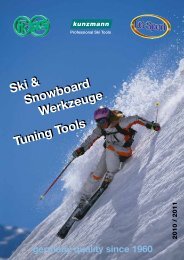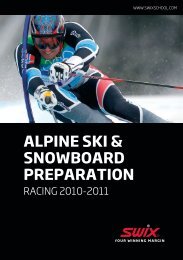NORDIC SKI PREPARATION
NORDIC SKI PREPARATION
NORDIC SKI PREPARATION
You also want an ePaper? Increase the reach of your titles
YUMPU automatically turns print PDFs into web optimized ePapers that Google loves.
APPLICATION OF CERA F<br />
Powder, Solid Turbo and Liquid<br />
Cera F Powder Application Tips<br />
Base Pretreatment<br />
Before Cera F is applied, the base is treated with<br />
the wax matching the day’s conditions. The higher<br />
the fluoro content in the wax (such as HF),<br />
the better the Cera F is bonded to the base.<br />
Scraping and thorough brushing is required before<br />
applying Cera F.<br />
Application by ironing<br />
When there is a need for Cera F to stay on the<br />
base for a long time, as in distances above 5 km,<br />
Cera F should be applied with an iron. First<br />
the powder is distributed evenly on the base.<br />
A 30 gram container will be enough for approximately<br />
4 pairs of classic skis, or 3 pairs of skating<br />
skis.<br />
The recommended temperature setting on the<br />
iron is 160°C (320°F) for FC7, FC8X and FC10X.<br />
The recommended temperature for ironing<br />
FC78 is 165°C (330°F).<br />
When ironing FC8X and FC10X only one<br />
continuous pass of the iron is needed. Make one<br />
pass with the iron on each side of the groove.<br />
The movement of the iron should be approximately<br />
4-5 seconds from tip to tail (skating ski).<br />
When using FC78 and FC7, after cooling, the<br />
powder is “brushed up“ (not brushed away) by<br />
using a back and forth scrubbing motion with the<br />
stiff Black Nylon Brush (T194). Afterwards, make<br />
another single pass with the iron. See page 36-39<br />
for “Step by Step Application”.<br />
APPLICATION BY IRONING<br />
FC78 and FC7<br />
FC8X and FC10X<br />
Brushing<br />
Before brushing allow the skis to cool for about<br />
5 minutes. Use the Swix Black Nylon Brush (T194)<br />
first, then the Wildboar Brush (T164). No scraping<br />
is needed.<br />
Finish with the Swix Polishing Brush (T160).<br />
All final brushing is done in a direction from tip<br />
to tail.<br />
Application of powder by corking<br />
This applies to short sprint cross country races of<br />
about 2 to 5 km.<br />
The powder is distributed evenly on the base.<br />
Less is used than when ironing. Use the Swix<br />
Synthetic Cork (T0010), or Swix Natural Cork<br />
(T0020). Use firm back and forth pressure to create<br />
heat to form a waxy layer. Next “brush-up” the<br />
powder with a Horsehair Brush (T157), and then<br />
cork into the base once again. Finish by brushing<br />
with the Swix Horsehair Brush (T157), and then<br />
the Swix Polishing Brush (T160).<br />
SAFETY RECOMMENDATIONS<br />
• Wax room ventilation. Make the extra effort to see that the area where<br />
you work on skis has exhaust fans and fresh air supply. Race organizers<br />
usually give the location for working on race equipment too low a priority,<br />
and often the waxing areas have little or no ventilation.<br />
• Do not expose waxes to open flames such as from a waxing torch, heat<br />
guns, space heaters, fire places, etc. Do not smoke cigarettes while waxing<br />
with fluorocarbon or fluorinated hydrocarbon waxes. In fact, don’t<br />
smoke at all! There is a chemical danger associated with fluorocarbon<br />
waxes when they are overheated. If fluorocarbon waxes are exposed to<br />
a heat source having a temperature higher than approximately 300°C<br />
(570°F), the fluorocarbon material disintegrates developing a poisonous<br />
gas. Normal iron temperatures will not cause a harmful breakdown of Swix<br />
waxes.<br />
• When using power brushes for brushing waxes a substantial amount of<br />
wax “dust” particles occur. To prevent inhalation of the particles use a<br />
“particle” mask. This can be the paper-type used in wood working.<br />
• Use safety glasses when power brushing.<br />
• If you question the quality of the waxes you are using, or feel that your<br />
exposure amount to waxing is extensive, use a respirator mask. It should<br />
be a cartridge type for filtering organic vapors. This type of mask is important<br />
to use when doing base repair with a burning polyethylene repair<br />
candle or base welder.<br />
• Be aware of the type of base cleaner you are using. Have good ventilation.<br />
And dispose of the rags or Fiberlene properly.<br />
• The addition of fluorocarbon materials into the hardwaxes and klisters<br />
means they must not be exposed to open flames of any type.<br />
Waxing torches should not be used for application or removal of fluorinated<br />
kick waxes. During application the warming-in of the wax with an iron is<br />
acceptable. Use a solvent for removal.<br />
Application by Roto Fleece<br />
Some teams prefer this method as it saves the ski<br />
somewhat from the very hot irons. Has also given<br />
excellent results re. Glide. See page 40 for “Step<br />
by Step Application”.<br />
34 35





